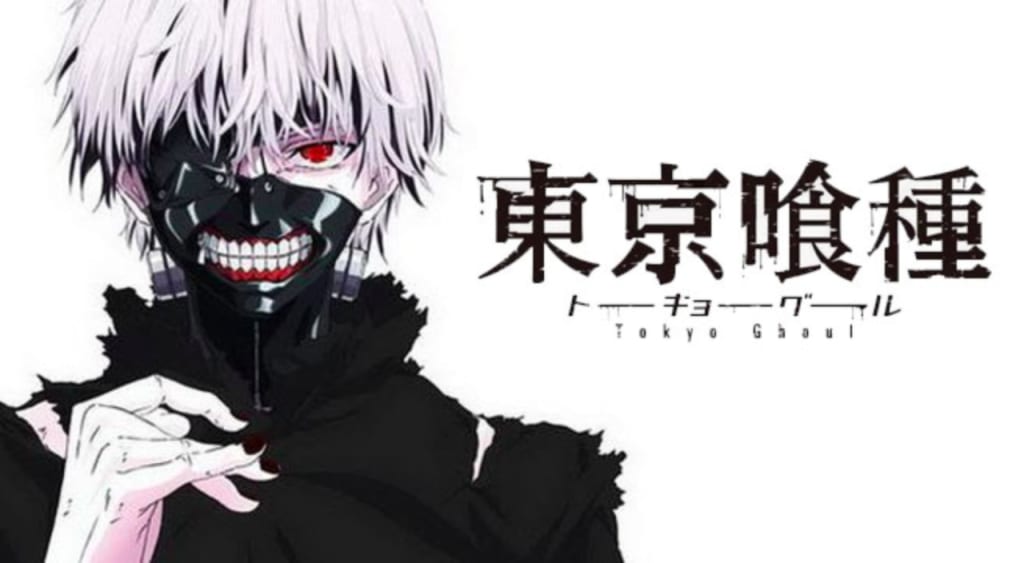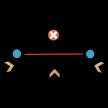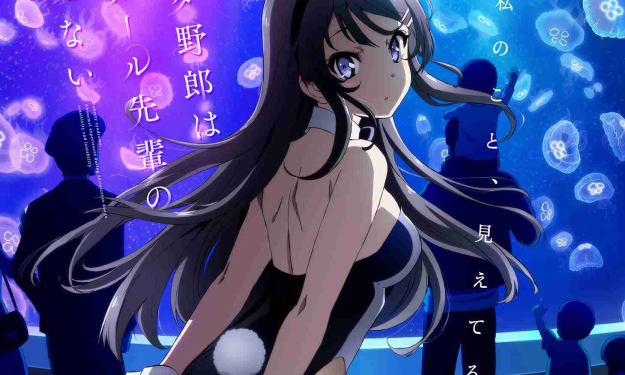
Having watched the first episode of Tokyo Ghoul four and a half years ago and keeping up with the series until the conclusion in December of 2018 has been a journey comprised of 48 20-minute long episodes in total. In that near half a decade, I have been in education, worked for a year, and am now in my final year of film school. Having watched the final episode of Tokyo Ghoul and reflecting on the time investment that it had taken to get from the start to the finish, I was left asking myself if it had been worth going back to it over and over again.
Tokyo Ghoul, and the sequel manga Tokyo Ghoul:re are two dark fantasy mangas written and illustrated by Sui Ishida that ran in the Weekly Young Jump magazine. The original series ran from 2011 to 2014, and the sequel ran from 2014 to 2018. The series was engaging to read with good layouts, detailed images, and incredibly distinct characters that stood apart from each other, both in terms of personality and in character design.
All four seasons of the anime were produced by Studio Pierrot, the same studio behind the adaptations of Naruto, and Bleach (two of the once big three). The series follows Kaneki Ken, a human, who after an accident gets turned to half ghoul and half human, and the various individuals that he comes into contact with both in the human world and the ghoul world.
The first season had a definitive arc structure as the audience is gradually introduced to many of the big players in the narrative, and while the pace of the show may slow down, it makes up for it by having a group of interesting characters and a strong central hub in the form of the coffee shop, Anteiku. Anteiku is run by ghouls where both ghouls and humans can interact, and in turn become a surrogate family for Kaneki after the accident.
The points in season one that were highlights are when the story focused on Kaneki, and his various interactions, Touka and Hideyoshi being particular standouts. However, when Mado and Juuzo were introduced to the story, the plight of the CCG (Commission of Counter Ghouls) is brought into the equation. This creates an interesting dynamic between the ghouls and the humans where they are both fighting each other without truly knowing the reasons why, setting up an interesting allegorical comparison of racial tensions in our own world.
What season one does well is bringing sympathy for both causes by focusing on the individual characters rather than the races as a whole, displaying that within both races, there are those that stand for good, and those who stand to destroy that very same good. At no point did I find myself hating any of the characters for their actions because their motivations are always crystal clear.
The standard of the animation is maintained at a high quality, and if one is to watch the unaltered versions the sheer amount of gore and blood is at times off putting. One clear statement of praise that could be given to this season is that it is a visual treat for the eyes, and at times is even quite avant garde. This is attributed to the vision of season director Shuuhei Morita, who has been nominated for an academy award for the anime short he directed Possessions.
With all that said the true highlight of not only this season but the series as a whole is the fantastic original score composed by Yutaka Yamada. The score accentuates scenes to raise there standard, and at times completely overshadows the anime itself.
With the praise being out of the way, my main criticism is how the series more or less grinds to a halt when the ever flamboyant Shuu Tsukiyama entered the show. His personality contrasted so heavily from the tone of the rest of the show that whenever he was on screen he took me out of the narrative.
Moving on to season two. Things started to fall apart ever so slightly. While the tone of the aesthetics of the show were consistent with the first season, the narrative took a departure from the original manga in favour of its own narrative. With in itself is nothing a bad thing, however the direction the series took with a number of characters, along with their motivations, completely broke the logic set up in the first season. This was not something done slowly over time, this was something done in the first episode of the second season with the central character Kaneki.
The remainder of the second season had an uphill battle to fight as a slew of new characters continued to be introduced in the show, and with decreasing amounts of time do develop them all. What makes things worse is that the show started to deviate from the intimate narrative that was set up in the first season where it focused more on the individuals that lived in the world, and how the world as a whole around them affected them all in different ways, the show focused more and more on the world and the politics that goes on with each race and set up the larger mythology of this world.
In many ways, the second season focused less and less on the set up in the first season. The main victim of this change was Touka, who was a force to be reckoned with, and was relegated to a glorified cheerleader.
Despite the fact that there are a lot of issues with this season, it is one I enjoyed quite a bit. As I stated earlier, the visuals, and the music were top notch. In addition there was an improvement in the fight sequences.
Season three and four saw a shift in directorial duties as Odahiro Watanabe took over, having previously worked on Beelzebub and Log Horizon. Season three also took the hit as one of the weakest follow up seasons for any anime. This was a season that I found difficult to actually watch, as a result of the severe dip in quality.
Season three begins a few years after the end of season two, and the audience is bombarded with a slew of new characters, in addition to the more veteran characters, ballooning the cast even more to the point that it felt as if characters were introduced only to be killed off a couple of episodes later, for the sake of having a character death. This carried on to the point that I started to tune out whenever a new character appeared, and did not even bother to remember their names. Characters felt superfluous, and their motivations were not revealed until a few seconds before they died in the form of a flash back.
The greatest detriment to the series is the fact that they moved away from the coffee shop, and started to focus on the world at large. Juuzo, one the most interesting characters from the first season, got little to no character development in the final two seasons. CCG officers were introduced with incredibly unique designs that helped them stand apart only to have them die a moment later, and the same goes for many of the ghouls. The coffee shop was brought up briefly every so often, if one counts, you could actually count all the minutes you spend in the coffee shop on a single hand through the entirety of season three. This naturally meant that Touka and the rest of the original company are even more in the back ground than they already were.
Once more everything pertaining to Kaneki in this season was interesting, and there were multiple scenes with his new family in CCG, after his season two defeat to Arima, that were pleasant and even quite enjoyable. While there was no great improvement in the fights, there was not a great decrease in the quality either, however with the sheer number of fights this season, it felt monotone, and of little interest.
The fourth and final season is a return to form for the Tokyo Ghoul franchise. It is curious that both seasons that had an OP which carried a song by TK, were in fact the best seasons of the show.
Season four finally stops introducing new characters, and starts to focus on, and even bring back minor characters from season one to have prominent roles. The structure of the show transformed into one that allowed the light to be shone on the characters rather than the world, and this allowed me to know more about them and sympathise with them when it comes to their eventual demise.
One thing that was not up to par with previous seasons is the fight sequences, which at this point had become quite dull, and incredibly repetitive. It got to the point that predicting the next move was so simple from the part of the viewer that you find yourself thinking that the characters are incapable of learning from their mistakes.
There were moments when the quality of the animation started to dip in quite a noticeable way for the first time in the series, where character models and their movements in static scenes were quite a bit off, and one could see just how out of proportion their facial feature are.
I would personally take a reduction in presentation quality if it meant that I got a significant increase in the quality of its narrative, and thankfully this was the case. Episodes seven, and eight, being two of the best episodes in the entire series for me. These episodes goes back to the dynamic that Kaneki and Touka had in season one, when the show was at its strongest. By this point the show had managed to get me to care about Urie as well, and by the time the eighth episode is concluding, I was getting the same feelings I got when I watched the first few episodes of Attack on Titan, or some of the deaths in Game of Thrones. The show had me on the edge and made me wish the characters I care about wouldn’t die.
One of the most glaring weaknesses of the show is its humour, that is unless the humour is coming from Hideyoshi. The final season is a fine example of how humour falls flat in this series, with examples of it being timed off, and being in awkward moments in the narrative, along with the gags being stock anime gags that have been used for years. No where is this more evident than with the final villain of the series, which is a shame because he has a few moments of brilliance in the climax.
Ultimately, was the journey satisfying? Yes, I found it to be so. Was the journey worth it? No, the show had far too many moments where I was forcing myself to watch than me enjoying myself. Would I recommend it? This I find difficult because the show is aesthetically brilliant, and the soundtrack is one of the best in recent time. However, the narrative is meandering with the requirement of a spreadsheet to keep track of all the characters and their convoluted motivations. So, I would recommend you watch three episodes. The opening is quite strong, and if it is something you want to continue would be up to you. You can currently stream the show on Funimation.
About the Creator
BoblobV2
Writing about anime, and anything else I find interesting.






Comments
There are no comments for this story
Be the first to respond and start the conversation.